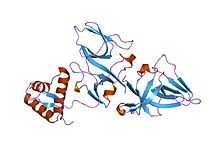Repressor lexA
| LexA DNA binding domain | |||||||||
|---|---|---|---|---|---|---|---|---|---|
 lexa s119a mutant | |||||||||
| Identifiers | |||||||||
| Symbol | LexA_DNA_bind | ||||||||
| Pfam | PF01726 | ||||||||
| Pfam clan | CL0123 | ||||||||
| InterPro | IPR006199 | ||||||||
| SCOP | 1leb | ||||||||
| SUPERFAMILY | 1leb | ||||||||
| |||||||||
Repressor LexA or LexA is a repressor enzyme (EC 3.4.21.88) that represses SOS response genes coding for DNA polymerases required for repairing DNA damage. LexA is intimately linked to RecA in the biochemical cycle of DNA damage and repair. RecA binds to DNA-bound LexA causing LexA to cleave itself in a process called autoproteolysis.
DNA damage can be inflicted by the action of antibiotics. Bacteria require topoisomerases such as DNA gyrase or topoisomerase IV for DNA replication. Antibiotics such as ciprofloxacin are able to prevent the action of these molecules by attaching themselves to the gyrase - DNA complex. This is counteracted by the polymerase repair molecules from the SOS response. Unfortunately the action is partly counterproductive because ciprofloxacin is also involved in the synthetic pathway to RecA type molecules which means that the bacteria responds to an antibiotic by starting to produce more repair proteins. These repair proteins can lead to eventual benevolent mutations which can render the bacteria resistant to ciprofloxacin.
Mutations are traditionally thought of as happening as a random process and as a liability to the organism. Many strategies exist in a cell to curb the rate of mutations. Mutations on the other hand can also be part of a survival strategy. For the bacteria under attack from an antibiotic, mutations help to develop the right biochemistry needed for defense. Certain polymerases in the SOS pathway are error-prone in their copying of DNA which leads to mutations. While these mutations are often lethal to the cell, they can also lead to mutations which improve the bacteria's survival. In the specific case of topoisomerases, some bacteria have mutated one of their amino acids so that the ciproflaxin can only create a weak bond to the topoisomerase. This is one of the methods that bacteria use to become resistant to antibiotics.
Impaired LexA proteolysis has been shown to interfere with ciprofloxacin resistance.[1] This offers potential for combination therapy that combine quinolones with strategies aimed at interfering with the action of LexA either directly, or via RecA.
LexA contains a DNA binding domain, this is a variant form of the helix-turn-helix DNA binding motif.[2] it is usually located at the N-terminus of the protein.
References
- ↑ Cirz RT, Chin JK, Andes DR et al. (2005). "Inhibition of mutation and combating the evolution of antibiotic resistance". PLoS Biol. 3 (6): e176. doi:10.1371/journal.pbio.0030176. PMC 1088971. PMID 15869329.
- ↑ Fogh RH, Ottleben G, Ruterjans H, Schnarr M, Boelens R, Kaptein R (September 1994). "Solution structure of the LexA repressor DNA binding domain determined by 1H NMR spectroscopy". EMBO J. 13 (17): 3936–44. PMC 395313. PMID 8076591.
This article incorporates text from the public domain Pfam and InterPro IPR006199